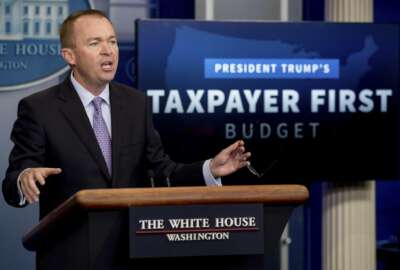So far, Congress has been relatively quiet on a pay raise for federal employees in fiscal 2018, meaning civilian workers are one step closer toward a 1.9 percent boost next year.
That’s what President Donald Trump offered in his 2018 budget proposal, which the administration released in its entirety in May.
The House Appropriations Financial Services and General Government Subcommittee passed its 2018 appropriations bill through a voice vote Thursday afternoon. The draft does not offer an alternative to the president’s proposal of 1.9 percent raise.
Trump proposed a 2.1 percent pay raise for members of the military. The Senate agrees with the president’s proposal, but the House Armed Services Committee suggested a 2.4 percent raise for troops next year.
A 1.9 percent raise for civilian workers is in line with the annual pay adjustment formula set under Title 5 of the U.S. Code for most federal employees under the General Schedule.
That formula equals the percentage increase in the Employment Cost Index (ECI) between September 2015 and September 2016, less than one half of a percentage point.
The president can choose to differ from this formula, and Congress can ultimately propose and pass any alternative numbers in its budget.
Congress has been busy this week marking up appropriations bills, and that work will likely continue when lawmakers return from a short recess after the July 4th holiday.
The Senate Appropriations Financial Services and General Government Subcommittee has not yet scheduled a markup of its own appropriations bill.
Neither bill will address the president’s proposals on federal retirement, because appropriations only address annual discretionary funding, not mandatory funding.
Congress could include the president’s retirement proposals in a larger legislative agreement, where savings from the cuts would be used to pay for other spending priorities or tax reductions.
Or, Congress could include such proposals in the budget reconciliation legislation.
Budgets tightening for GSA
The bill also includes a little less than $8 billion for the General Services Administration’s Federal Buildings Fund, nearly $2 billion less than what the agency requested.
It also includes $20 million for GSA to create an Asset Proceeds and Space Management Fund, half of the administration’s request of $40 million. The revolving fund is designed to help agencies update or sell off under-utilized or vacant federal buildings.
The bill provides no appropriations for construction and acquisition.
Rep. Tom Graves (R-Ga.) recognized the budgetary shortfalls for the agency and said he described the cuts as “merely a math issue” to acting GSA Administrator Tim Horne.
“We recognize this is well below their initial request, but we did make sure to include sufficient funds for the maintenance and repairs of existing buildings, just knowing that we had limited resources [and] that we were going to put our focus on taking care of what we have today and anticipating, hopefully, additional resources in the future,” he said. “And [then] we can look back toward construction. It’s certainly lean times today.”
During budget hearings in May, the subcommittee’s ranking member, Rep. Mike Quigley (D-Ill.) said he was “disappointed and perplexed” that the Trump administration’s request didn’t include more funding to begin the acquisition and construction of a new consolidated FBI headquarters.
OPM modernization
The Office of Personnel Management would also see fewer dollars than what it had originally requested.
The House appropriations bill includes $18 million IT modernization efforts, nearly $20 million less than OPM’s original request of $37 million.
In its budget justification to Congress, OPM said it would dedicate those resources toward consolidating remaining data centers, funding the continuous diagnostics and mitigation (CDM) program and other cybersecurity tools, upgrading outdated IT infrastructure and migrating or modernizing legacy systems, including the Trust Fund Federal Financial System.
OPM won’t receive the $18 million until it submits a spending plan to the House and Senate appropriations committees. The agency must work with the Office of Management and Budget, as well as the U.S. Digital Service and Homeland Security Department to develop the plan.
OPM has long advocated for more funding to update its IT systems, particularly to transfer its retirement claims processing system to a paperless one.
In fiscal 2016, the agency processed 77.1 percent of retirement claims within 60 days, below OPM’s goal of a 90 percent processing rate.
Copyright
© 2024 Federal News Network. All rights reserved. This website is not intended for users located within the European Economic Area.
